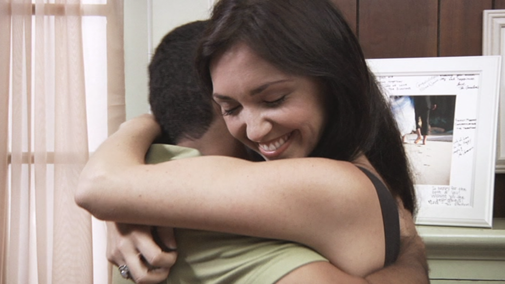Made for Life, Part 2: "You give yourself, then, totally and completely…"

Background: We’re reading through the Viewer’s Guide to “Made for Life,” a video about the gift of children and the need for fathers and mothers. In the last installment, we looked at what openness to life means and why love and life are inseparable. In this section, we’ll reflect on the unique gift of self in marriage and how that gift of self opens to the gift of life.
“You give yourself, then, totally and completely . . . saying ‘I love you so much, I’m going to give myself to you as a gift, and I am open to whatever that brings and whatever God wants.’”
Katie is speaking here about the very foundation of what makes marriage “made for life”: the total gift of self between a man and a woman as husband and wife. We have already mentioned this gift of self in marriage, but it deserves some more attention. Indeed, every person is called to a generous and sincere gift of self. [i] But marriage is a unique instance of self-gift. In marriage, husband and wife give not just part of themselves to each other, but give all—their whole person, body and soul. This gift of self in marriage is not something temporary like a loan; it is meant to last for a lifetime. [ii] It is a total, lifelong gift of husband to wife and wife to husband. [iii]
A husband and a wife’s total gift of self in marriage, with its lifelong permanence, makes their bond absolutely unique and different from any other relationship between two people. Although two persons of the same sex can have an authentic and holy friendship, only a man and a woman can pledge themselves to each other in marriage. Through their sexual difference, only a husband and a wife can speak the “language” of married love—total, faithful, and fruitful self-gift [iv]—not only with their words, but also with their bodies. [v]
The couples in Made for Life all bear witness to the fact that the gift of self in marriage, which begins with the spouses, does not end with them. As Pope Paul VI taught, married love is fruitful because “it is not confined wholly to the communion of husband and wife; it also aims to go beyond this to bring new life into being.” [vi] Precisely because husband and wife are “made for each other,” their bond is “made for life,” made for fruitful love and for the adventure of fatherhood and motherhood by being open to the gift of a child.
[i]. See Gaudium et Spes, no. 24: “Man is the only creature on earth that God has wanted for its own sake . . . [and] can fully discover his true self only in a sincere giving of himself.”
[vi]. Humanae Vitae, no. 9 (translation modified). See also Marriage: Love and Life in the Divine Plan, 16: “The transmission of life is a sublime, concrete realization of this radical self-gift between a man and a woman . . . As mutual self-gift, it is at the same time creative self-gift.”